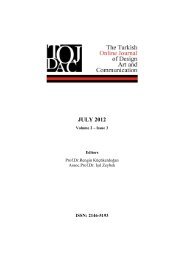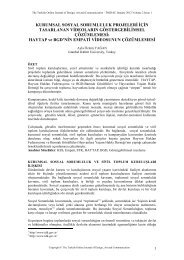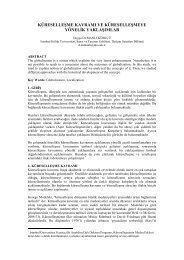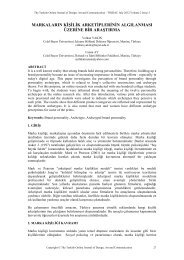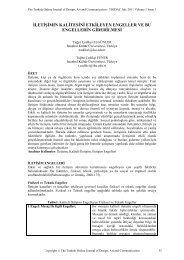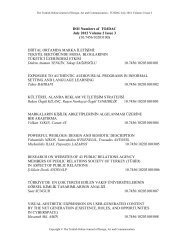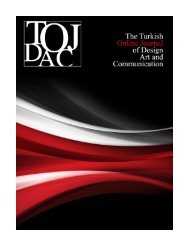aprıl 2012 - tojdac.org
aprıl 2012 - tojdac.org
aprıl 2012 - tojdac.org
Create successful ePaper yourself
Turn your PDF publications into a flip-book with our unique Google optimized e-Paper software.
The Turkish Online Journal of Design, Art and Communication - TOJDAC April <strong>2012</strong> Volume 2 Issue 2<br />
production firms started to make professional films, which used ‘amateur way’ of story<br />
telling.<br />
2. CLASSICAL NARRATIVE<br />
Classical narrative is based on continuity editing. In continuity editing the cuts should not<br />
take the attention of audience, that’s why best cut was used to be the invisible cut where film<br />
editing was also called the invisible art. To construct a lucid continuity the first aim is to find<br />
a way to make a smooth cut. Making a smooth cut means cutting two neighbor frames in a<br />
way that the cut should not take unnecessary attention (1). Especially, the word<br />
“seamlessness” has become a popular term in effective film editing. An invisible cut is the<br />
first goal of a director or an editor. It is not easy to describe the appropriate cut point but the<br />
audience definitely understands when it is inappropriate. Filmmakers call these inappropriate<br />
cuts “jump-cuts” and the director must take care of “matching action”, “matched framing”,<br />
“screen direction”, “similar setting” and “tone, rhythm and pace” (2).<br />
2.1 Matching action<br />
If a man is shot when walking into a room and if we see him sat on a chair the other frame<br />
that cut would definitely take attention and the illusion of continuity will be broken (3). That’s<br />
why the director should show the man while sitting down for not letting his audience to be<br />
interrupted by the cut.<br />
2.2 Matched framing, similar setting, screen direction<br />
Cutting someone from long shot to a mid-shot, the director should think about how to frame<br />
his actor. Cutting from long shot of a man to another long shot of the same character would be<br />
noticeable because the visual information would not be changing enough. Cutting the<br />
neighbor framings would not be enough as the director should choose from long shot to<br />
medium, close up to get enough change in the visual information. Another thing that should<br />
not be f<strong>org</strong>otten is to change the position of the camera to at least 30 degrees. That’s how we<br />
can change the visual information in the background (4). The light and color should not<br />
change in between shots for continuity editing. The exposure and the color temperature for<br />
each shot should be similar. Also, the screen direction is very important for continuity editing.<br />
The character should move to the same direction in each shot unless he changes his walking<br />
direction, and even if he changes his direction the change should be shown to the viewer. If a<br />
director shoots a film b using a classical narrative style he or she should take the topics which<br />
were told above into considration. The purpose of classical narrative is to create and<br />
emotinoal reaction on the audience when its first screening. Thats why the viewer should<br />
f<strong>org</strong>et that he or she is watching a film. When ever there is a noticable cut it will not be easy<br />
to create the desired emotinal reaction.<br />
3. “A NEW WAY” OF STORY TELLING<br />
From the director’s point of view there seems like having two main problems; first one is the<br />
reason for using amateur video look in a professionally produced film. The second one is to<br />
legalize the usage of amateurish camera movements and editing. Before answering these<br />
questions we should discuss what the principles of amateur approach are. As most filmmakers<br />
know, classical narrative is based on continuity editing. One of the most important purposes<br />
of using continuity editing is to convert real time into screen time without distracting the<br />
audience or confusing them (3). That’s why the audience will be seeing fragments from a<br />
scene but still will not lose the illusion of continuity. By the help of continuity editing the<br />
viewer can feel emotionally connected to the main character, then he would feel the tension<br />
and in the end of the film the director will be able to get the emotional reaction from the<br />
viewer. The main purpose of filmmaking, which uses classical narrative, is to get an<br />
emotional reaction from the audience not a critical one.<br />
Copyright © The Turkish Online Journal of Design, Art and Communication 2



